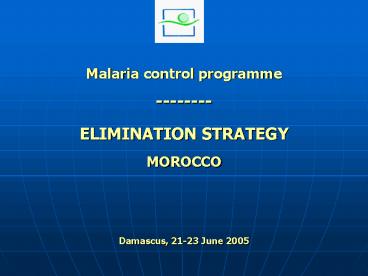Malaria control programme - PowerPoint PPT Presentation
1 / 13
Title:
Malaria control programme
Description:
1998: Control of the epidemiologic situation: 68 cases. 1999: ... To eliminate the autochthonous malaria by 2006. To control the ... national comity of IVM ... – PowerPoint PPT presentation
Number of Views:56
Avg rating:3.0/5.0
Title: Malaria control programme
1
- Malaria control programme
- --------
- ELIMINATION STRATEGY
- MOROCCO
- Damascus, 21-23 June 2005
2
Malaria in Morocco History
- 1965 Malaria control programme 30.000 cases
- 1975 Eradication of malaria due to P.falciparum
- 1998 Control of the epidemiologic situation 68
cases - 1999 Elimination strategy
3
Elimination strategy Objectives
- To eliminate the autochthonous malaria by 2006
- To control the imported malaria
4
Objective 1 To eliminate malaria in 2006
- Intensifying of control actions
- - intensive and targeted case detection
(residuals - carriers)
- - intensive vector control
- Promotion of the intersectoralle collaboration
- - elimination of risk factors
- International collaboration
- - technical and financial support (RBM Project)
5
Objective 2 To control the imported malaria
- Prevention
- - Chemoprophylaxis and advices to
travelers - - Health control at the borders
- Control Early diagnosis and treatment
6
Elimination strategy Epidemiologic situation
- Autochthonous malaria
- 2002 Focus of transmission at Chefchaouen 19
cases - 2003 No transmission (4 residuals cases)
- 2004 No transmission (1 residual case)
- Imported malaria
- 2003 67 cases
- 2004 55 cases
7
Annual distribution of malaria cases,1980 -
2004
8
Elimination strategy Achievements
- Maintain of the vigilance
- - Annuals meetings to study the provincial plans
of actions - - Supervisions at the field
- - National assessment at middle term in 2004
- Reinforcement of the surveillance activities and
quality control - - Establishment of a network of 8 sentinel sites
of insecticide resistance monitoring and
mosquitoes identification - - Creation of regional laboratories of quality
control - - Maintain of activities of surveillance at
high level - Mobilization at the field
- - Extension of the zones at risk31provinces at
risk in 2004 - - Campaign of vector control by biological
action (malaria african day 04) - - Mapping of breeding sites of mosquitoes
9
Elimination strategy Achievements
10
Elimination strategy Achievements
- Training and retraining
- - retraining of 15 technicians of microscopy in
2003 - - training of 10 technicians of microscopy in
2005 (regions) - training of the personnel in charge of resistance
monitoring - Heighten awareness on the use of GIS in mapping
of breeding sites of mosquitoes - review of the strategy of imported malaria
control. - Intersectoral collaboration
- - Establishment of national comity of IVM
- - Involvement of other sectors in imported
malaria control (malaria african day 05)
11
Constraints
- Resources reduction
- - Humans (volunteer retirement)
- - Financial
- Insufficiency of
- - Intersectoral collaboration
- - Community participation
- Illegal immigration (Africans south of sahara)
12
Conclusion Objectives 2005-2006
- To consolidate the stop of the transmission
- - To maintain activities of surveillance
- - To eliminate risk factors
- To control of the imported malaria
- - Prevention and early diagnostic and treatment
of - the cases
- - Health control at the borders
- To reinforce intersectoral collaboration
13
- Thank you































![[Country] Malaria Indicator Survey [Year] PowerPoint PPT Presentation](https://s3.amazonaws.com/images.powershow.com/5376977.th0.jpg?_=20140824115)